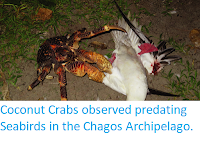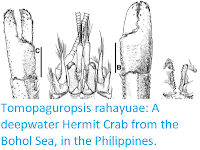Porcelain Crabs, Porcellanidae, are small Decapod Crustaceans closely related to Squat Lobsters. They closely resemble True Crabs, Brachyura, to which they are only distantly relates, an example of convergent evolution. Porcelain Crabs have wide, flattened bodies, a shape which enables them to hide in crevices, and large claws, which are used in disputes with other members of the same species, but not for feeding. Porcelain Crabs are rather delicate, and easily shed limbs to escape predators, which gives them their common name.
In a paper published in the journal ZooKeys on 8 August 2018, Alexandra Hiller of the Smithsonian Tropical Research Institute, and Bernd Werding of the Institut für Tierökologie und Spezielle Zoologie der Justus-Liebig-Universität Giessen, describe a new species of Porcelain Crab from the Philippines and Indonesia.
The new species is placed in the genus Aliaporcellana, and given the specific name spongicola, meaning 'Sponge-dwelling'; the species was found living in the folds of large barrel sponges of the genus Xestospongia. The species is brightly coloured, with a bright orange shell with a reticulate bright blue pattern and a broad black band crossing the shell behind the head. As such it has been photographed numerous times by divers, but not formally described to date.
Aliaporcellana spongicola. Female (ovigerous) Philippines, Oriental Mindoro Province, Mindoro, Puerto Galera, off Bayanar Beach. Scale bar: 3.5 mm.
The species was found on reefs around the central Philippines and northern Sulawesi, Indonesia. It is the sixth species assigned to the genus Aliaporcellana, and the second species found to be commensual with another organism (Aliaporcellana telestophila lives on Corals of the genus Solenocaulon). This causes Hiller and Werding to question whether other members of the genus might have similar relationships, which have been overlooked.
See also...
Follow Sciency Thoughts on Facebook.







